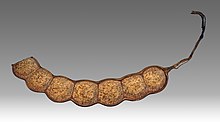Entada phaseoloides
| Entada phaseoloides | |
|---|---|
 |
|
| E. phaseoloides pod specimen in the Muséum de Toulouse | |
| Scientific classification | |
| Kingdom: | Plantae |
| (unranked): | Angiosperms |
| (unranked): | Eudicots |
| (unranked): | Rosids |
| Order: | Fabales |
| Family: | Fabaceae |
| Subfamily: | Caesalpinioideae |
| (unranked): | Mimosoid clade |
| Genus: | Entada |
| Binomial name | |
|
Entada phaseoloides (Linné) Merr. |
|
| Synonyms | |
|
Acacia scandens (L.) Willd. |
|
Acacia scandens (L.) Willd.
Entada formosana Kaneh.
Entada koshunensis Hayata & Kaneh.
Entada rumphii Scheff.
Entada scandens (L.) "Benth., p.p."
Entada tonkinensis Gagnep.
Faba marina-major Rumph.
Gigalobium scandens (L.) Hitchc.
Lens phaseoloides L.
Mimosa blancoana Litv.
Pusaetha scandens (L.) Kuntze
Strepsilobus scandens (L.) Raf.
Entada phaseoloides commonly named the "box bean" or "St. Thomas’ bean", first described by Linnaeus, with its current name described by Merrill. E. phaseoloides is a liana in the pea family: called Gugo, Balugo or Tamayan in the Philippines and Bàm bàm in Viet Nam. No subspecies are listed in the Catalogue of Life.
Entatda phaseoloides is a large liana that climbs high into the lowland tropical forest canopy and found in lowland coastal forests of Africa, Australia, Asia and the Western Pacific. The lianas are often (but not exclusively) associated with waterways and seeds are widely dispersed by oceanic currents. Two subspecies have been described:
The leaf structure is bi-pinnate compound divided into 1-2 pairs of leaflets. Leaflets are somewhat elliptical, between 25 and 100 mm long and 10 to 60 mm wide. Flowers are arranged in a raceme with green to red coloured sepals and green / cream petals that are between 2-3.5 mm long. The characteristic pods can grow very large, up to 2 m long and 130 mm wide. Each pod contains between 10 and 20 reddish brown seeds that are lens-shaped and about 40 to 60 mm in diameter.
...
Wikipedia
